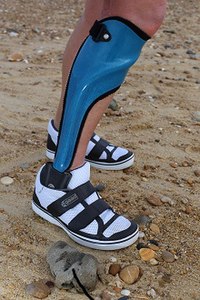
Photo from wikipedia
Background: Ankle sprain is the most common sport‐related injury and eccentric weakness of ankle evertors is regarded as a significant muscular deficit related to chronic ankle instability. However, the eccentric… Click to show full abstract
Background: Ankle sprain is the most common sport‐related injury and eccentric weakness of ankle evertors is regarded as a significant muscular deficit related to chronic ankle instability. However, the eccentric performance of the evertors is rarely assessed by clinicians because procedures used for research purposes (i.e. isokinetic tests) are not easily applicable in daily practice. Methods: The present study assessed the ability of two different testing procedures to distinguish between groups of 12 healthy subjects or 12 patients suffering from chronic ankle instability. On the one hand, the strength of evertors was assessed with a gold standard isokinetic procedure. On the other hand, we assessed the ability of the subjects to control ankle inversion during weight bearing (functional standing test). Findings: Data showed no significant difference between groups for isokinetic peak torque values normalized to body weight. Conversely, the functional test revealed a significantly impaired ability to control ankle inversion during weight bearing in subjects with chronic ankle instability. Interpretation: This suggests that this easy‐to‐apply functional test is better suited compared to isokinetic testing procedures to assess weakness of evertors in patients suffering from chronic ankle instability. Moreover, this test may also be used to objectively monitor improvements during rehabilitation or progression in prevention protocols. HighlightsThere is no clear consensus about the relation between chronic ankle instability and isokinetic evertors' weakness.Isokinetic tests didn't represent the most accurate way to evidence evertors' weakness in chronically unstable anklesFunctional tests, easy to implement in daily practice, are needed to assess ankle evertors' weaknessInversion velocity peak in weight bearing conditions represents a promising tool for eccentric evertors' weakness assessment.
Journal Title: Clinical Biomechanics
Year Published: 2017
Link to full text (if available)
Share on Social Media: Sign Up to like & get
recommendations!